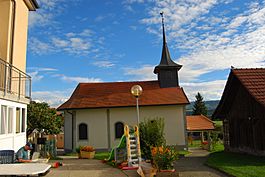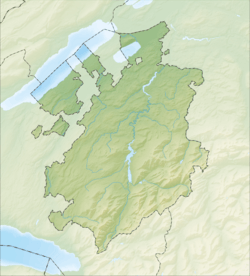Chénens facts for kids
Quick facts for kids
Chénens
|
||
|---|---|---|
 |
||
|
||
| Country | Switzerland | |
| Canton | Fribourg | |
| District | Sarine | |
| Area | ||
| • Total | 3.94 km2 (1.52 sq mi) | |
| Elevation | 696 m (2,283 ft) | |
| Population
(Dec 2020 )
|
||
| • Total | 843 | |
| • Density | 214.0/km2 (554.2/sq mi) | |
| Postal code |
1744
|
|
| Surrounded by | Autigny, La Brillaz, La Folliaz, Villorsonnens | |
Chénens is a small town, also called a municipality, located in the canton of Fribourg in Switzerland. It's part of the Sarine district. Most people in Chénens speak French. While it once had a German name, Geiningen, it's not used anymore.
Contents
History of Chénens
Chénens is quite old! The first time we see its name in historical records was in the year 1138. Back then, it was called Cheineis.
Geography of Chénens
Chénens covers an area of about 4 square kilometers (about 1.5 square miles). A big part of this land, almost 68%, is used for farming. About 22% of the area is covered by forests. The remaining 10% is where buildings and roads are located.
The town is situated on a main road that connects the cities of Fribourg and Romont (FR).
Chénens Coat of Arms
The coat of arms for Chénens has a special design. It shows a silver-colored dog, like a large Mastiff, walking across a red background. The dog also has a gold collar around its neck.
People of Chénens (Demographics)
Chénens has a population of 843 people. Over the past ten years, the number of people living here has grown by almost 20%. This growth is mostly because new people have moved to Chénens.
Most people in Chénens speak French as their main language, about 94% of the population. A smaller number of people, about 4%, speak German. Even fewer, less than 1%, speak Portuguese.
In Chénens, about 30% of the people are children and teenagers (under 20 years old). Most of the population, about 61%, are adults (between 20 and 64 years old). The remaining 8.5% are seniors (over 64 years old).
There are about 182 homes in Chénens, with an average of 3 people living in each home. Most of the apartments in the town are lived in all year round.
The chart below shows how the population of Chénens has changed over many years:

Economy of Chénens
In Chénens, there are different types of jobs.
- The primary sector involves farming. About 7 businesses are in this area.
- The secondary sector includes manufacturing and construction. There are 6 businesses in this sector.
- The tertiary sector covers services like sales, transportation, hotels, restaurants, and education. There are 20 businesses in this sector.
Many people who live in Chénens travel to other towns for work. About 73% of working people use a private car to get to their jobs.
Religion in Chénens
Most people in Chénens, about 86%, are Roman Catholic. A smaller group, about 4%, belong to the Swiss Reformed Church. Some people also belong to other Christian churches or are Islamic. About 5% of the population does not belong to any church.
Education in Chénens
In Chénens, about 34% of the people have finished high school. About 9% have gone on to get a higher education, like from a university.
The school system in Fribourg Canton works like this:
- One year of optional Kindergarten.
- Six years of Primary school.
- Three years of required lower Secondary school, where students are grouped by their skills.
- After that, students can choose to go to a three or four-year upper Secondary school. This can be a gymnasium (which prepares them for university) or a vocational program (which teaches job skills).
- Finally, students can go to a Tertiary school or start an apprenticeship.
During the 2010-2011 school year, Chénens had 3 primary classes with 68 students. Many students from Chénens attended schools in nearby towns for kindergarten, secondary, and higher education.
Transportation in Chénens
Chénens has its own railway station, called Chénens. This station is on the main train line that connects Lausanne and Bern. You can catch regular trains from Chénens to Romont FR and Fribourg/Freiburg.
Images for kids





